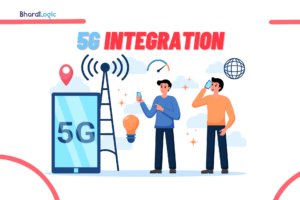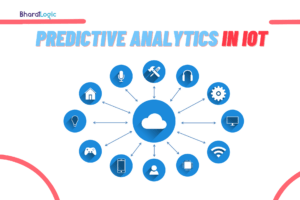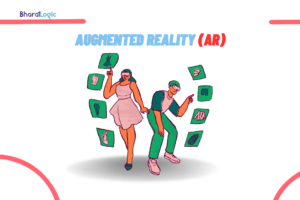Top Mobile App Development Trends to Watch In 2024
The landscape of mobile app development has evolved significantly over the past two decades. This progression has witnessed substantial advancements in the creation and adoption of new mobile app development frameworks. These frameworks contribute to the development of more efficient, high-performing, and enhanced applications.
In 2021, the mobile app development industry was valued at an impressive USD 174.61 billion. However, what truly captures attention is the projected Compound Annual Growth Rate (CAGR) of 14.10% from 2024 to 2032. To contextualize, this growth rate outpaces even the rapid ascent of the latest social media sensation.
The introduction of 5G networks marks a transformative moment. These networks enable mobile platforms to support massive data transfers at high speeds, ushering in a trend towards data-intensive, personalized, and experiential applications.
This technological shift not only reflects the industry’s resilience but also signals an exciting future where mobile applications become increasingly sophisticated, responsive, and tailored to meet the evolving needs of users. As we navigate this trajectory, the role of mobile app developers becomes even more pivotal in shaping the digital landscape.
There are various types of mobile apps available in the market, and selecting the right platform is crucial to align with the latest app development trends. Here are some of the top trends we anticipate will gain popularity in 2024.
5G Integration

In 2024, 5G technology stands as a pivotal force, revolutionizing how we interact with mobile apps. This era of connectivity introduces lightning-fast download and upload speeds, minimal latency, and an unprecedented surge in network capacity. It’s not just an upgrade; it’s a transformative leap into a dynamic and thrilling future.
The benefits are clear – users will experience unprecedented speed and efficiency. Downloading and uploading content will be seamless, offering a user experience unparalleled in its speed and responsiveness. However, with great connectivity comes significant responsibility. The widespread adoption of 5G raises legitimate concerns about security and privacy. Encryption, authentication, and stringent regulatory frameworks are vital to safeguard personal information and critical infrastructure. The potential is immense, but it comes hand in hand with the need for a secure and responsible digital ecosystem.
Those who embrace and harness the capabilities of 5G will undoubtedly set new standards, driving innovation and excellence in mobile app development.
Predictive Analytics in IoT

In the dynamic landscape of mobile app development, the convergence of the Internet of Things (IoT) and Predictive Analytics emerges as a powerful trend. This fusion holds transformative potential, offering far-reaching implications across various sectors.
Traditionally confined to smart homes, IoT now infiltrates diverse industries, delivering personalized healthcare experiences and predictive investment strategies in fintech through mobile apps. This convergence transforms mobile apps into gateways for intelligently connected ecosystems, enhancing operational efficiency, reducing costs, and promoting sustainability.
As we navigate this IoT and Predictive Analytics-driven future, developers hold the key to unlocking intelligent, connected ecosystems. By harnessing the potential of these technologies, developers can usher in a new era of app experiences that are not only intuitive but also predictive, setting the stage for a smarter, more efficient digital future.
On-Demand Apps

The surge of on-demand apps stands out as a defining trend, fundamentally altering the way we access services. This paradigm shift is driven by the pursuit of unparalleled convenience, transforming our smartphones into gateways for instant gratification.
From ride-hailing services to food delivery platforms, on-demand apps cater to the fast-paced lifestyles of users, offering services at their fingertips. The profound success of on-demand apps stems from their ability to seamlessly connect users with services, fostering a culture of immediacy and efficiency.
One key statistic underscores the significance of this trend: the global on-demand mobile app market is projected to reach a staggering $335 billion by 2025, reflecting the immense popularity and growth potential of on-demand services.
Blockchain in Mobile App Development

Blockchain technology has transcended its origins in cryptocurrency and is now a pivotal force in shaping the future of mobile app development. In essence, blockchain is a decentralized, distributed ledger that records transactions across multiple computers, ensuring security, transparency, and immutability.
In the context of mobile apps, blockchain brings a paradigm shift in data management and security. One of its key features is the ability to create smart contracts, self-executing contracts with the terms of the agreement directly written into code. This ensures trust and eliminates the need for intermediaries, reducing costs and enhancing efficiency.
A pertinent statistic highlights the growing relevance of blockchain: the global blockchain market is expected to reach $39.7 billion by 2025, signifying a widespread adoption across various industries.
Super Apps: Transforming the Mobile Experience

The concept of Super Apps is reshaping the way users engage with mobile applications. A Super App goes beyond its traditional functionality, offering a diverse array of services and becoming a one-stop solution for users’ daily needs. Think of it as an app ecosystem where users can access various services seamlessly.
China’s WeChat is a prime example, providing not only messaging features but also enabling users to shop, pay bills, order food, and more, all within the app. This trend is gaining traction globally as users appreciate the convenience of having multiple services consolidated in one application.
The statistics affirm the rise of Super Apps: as of 2021, 90% of Southeast Asian consumers use at least one Super App regularly.
Apps for Foldable Devices

According to the Counterpoint Research Foldable Tracker and Foldable Insight Report, the global foldable smartphone market increased 64% Year on Year in Q1 2023
Foldable devices offer increased screen real estate, enabling a more immersive user experience. Apps designed for foldable devices can seamlessly transition between different screen orientations, providing users with enhanced multitasking capabilities. For instance, a note-taking app could transform into a split-screen interface, allowing users to jot down ideas on one side while referencing information on the other.
With Samsung, Huawei, and other major players investing in foldable technology, the market for apps optimized for these devices is expanding. Users are drawn to the versatility and portability of foldable devices, and developers who embrace this trend are at the forefront of shaping the future of mobile app experiences.
As smartphones with foldable screens become more prevalent, developers are adapting to create apps that capitalize on this innovative form factor.
Voice User Interfaces (VUIs)

As natural language processing and voice recognition technologies advance, VUIs are evolving beyond simple commands to complex interactions. Mobile apps now allow users to perform various tasks, from sending messages to controlling smart home devices, solely through voice commands. This trend is particularly significant in creating inclusive app experiences, catering to users with disabilities or those who prefer verbal interactions.
The rise of virtual assistants AI like Siri, Google Assistant, and Alexa underscores the growing importance of VUIs. Developers who incorporate seamless voice interactions into their apps tap into a user-friendly future where speaking to your device is as common as tapping on the screen. With the increasing prevalence of smart speakers and voice-enabled devices, the era of Voice search User Interfaces is set to resonate across the entire mobile app ecosystem.
What do users expect from (VUIs)?
“Speech is the fundamental means of human communication. Even when other forms of communication – such as writing, facial expressions, or sign language – would be equally expressive, (hearing people) in all cultures persuade, inform and build relationships primarily through speech.”
—Clifford Nass and Scott Brave, Stanford researchers and authors
Augmented Reality (AR)

Mobile augmented reality (AR) market revenue worldwide from 2021 to 2026
Augmented Reality (AR) is not just a buzzword but a transformative trend that is reshaping the landscape of mobile app development. It introduces a layer of digital information onto the real-world environment, providing users with immersive and interactive experiences.
From gaming to retail, educational apps to navigation tools, the applications of AR are diverse and impactful. For instance, furniture shopping apps can use AR to allow users to visualize how a piece of furniture will look in their homes before making a purchase.
One of the key drivers behind the AR surge is the advancement in smartphone capabilities, with built-in sensors and cameras enabling AR functionalities. This technology goes beyond entertainment and adds practical value to everyday experiences. As AR becomes more sophisticated, users can anticipate more seamless integrations, blurring the lines between the physical and virtual worlds.
Conclusion
Mobile application trends of 2024 are not just passing fads; they represent a shift towards more immersive, efficient, and intelligent applications. Each trend, from 5G integration to the rise of Super apps, plays a unique role in reshaping user experiences and driving innovation. By understanding and embracing these trends, developers and businesses alike can position themselves at the forefront of innovation, driving the next wave of mobile app evolution.
Discover the power of custom mobile application with BharatLogic. With a team of experienced programmers and developers, Bharatlogic is the perfect digital partner for all your project needs. Find clarity and guidance in your journey with us by your side.
Interested in development? Check out Best Web Designing Companies in Chandigarh
FAQ’s
Q1: What is the expected Compound Annual Growth Rate (CAGR) of the mobile app development industry from 2024 to 2032?
A1: The projected CAGR for the mobile app development industry from 2024 to 2032 is an impressive 14.10%.
Q2: How does 5G technology impact mobile app experiences in 2024?
A2: 5G technology introduces lightning-fast download and upload speeds, minimal latency, and a surge in network capacity, creating a transformative leap into a dynamic and thrilling future.
Q3: What is the significance of Predictive Analytics in the convergence of IoT and mobile app development?
A3: Predictive Analytics in IoT enhances operational efficiency, reduces costs, and promotes sustainability by delivering personalized experiences and predictive strategies across various sectors.
Q4: What key statistic highlights the success of On-Demand Apps in the market?
A4: The global on-demand mobile app market is projected to reach a staggering $335 billion by 2025, showcasing immense popularity and growth potential.
Q5: Why is Blockchain considered a pivotal force in shaping the future of mobile app development?
A5: Blockchain ensures security, transparency, and efficiency in data management. Its ability to create smart contracts eliminates the need for intermediaries, reducing costs. The global blockchain market is expected to reach $39.7 billion by 2025.




